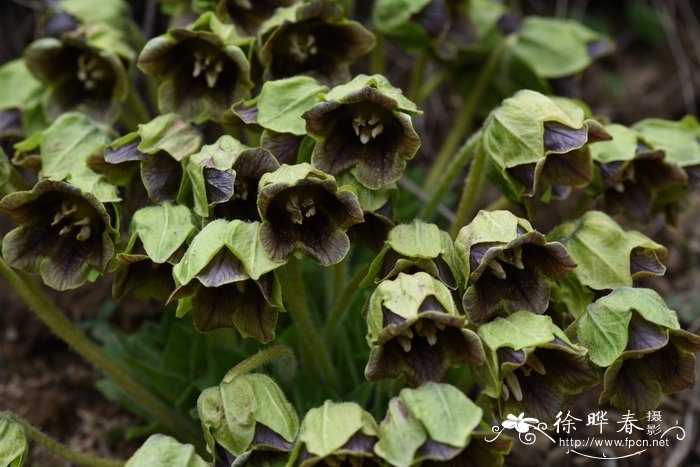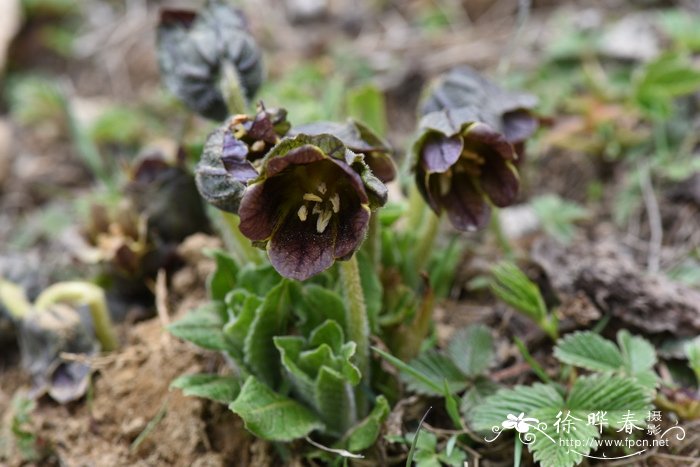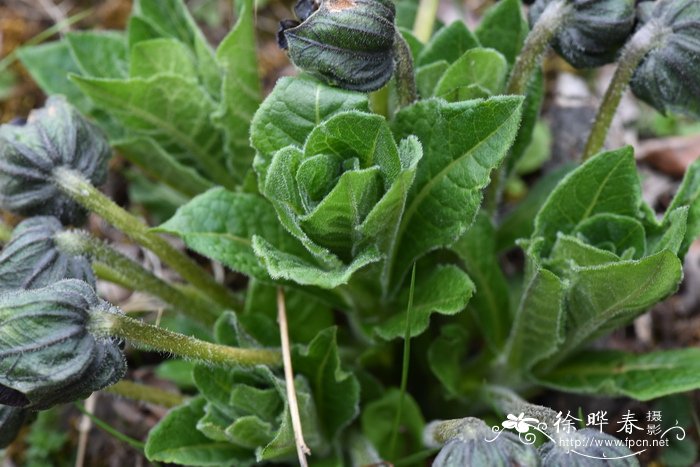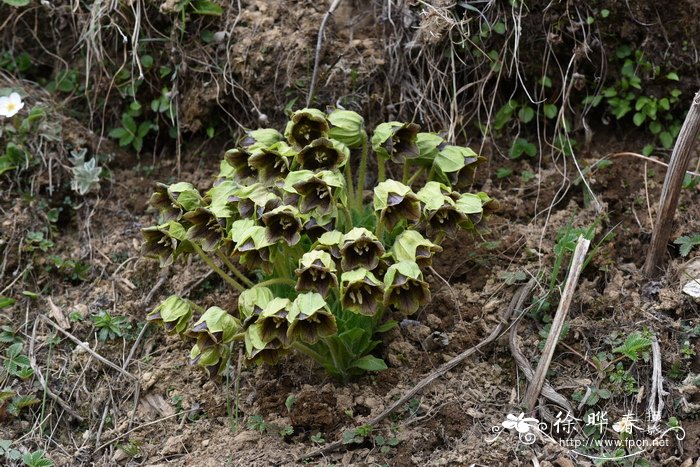茄参Mandragora caulescens
中文名(Chinese Name):茄参
学名(Scientific Name):Mandragora caulescens C. B. Clarke
英文名(English Common Name):
别名(Chinese Common Name):曼陀茄
异名(Synonym):Mandragora chinghaiensis Kuang et A. M. Lu Anisodus mariae Pascher Anisodus caulescens (C. B. Clarke) Diels Mairella yunnanensis H. Lév. Mandragora tibetica Grubov
科属(Family & Genus):茄科(Solanaceae)茄参属
形态特征(Description):多年生草本,高20-60厘米,全体生短柔毛。根粗壮,肉质。茎长10-17厘米,上部常分枝,分枝有时较细长。叶在茎上端不分枝时则簇集,分枝时则在茎上者较小而在枝条上者宽大,倒卵状矩圆形至矩圆状披针形,连叶柄长5-25厘米,宽2-5厘米,顶端钝,基部渐狭而下延到叶柄成狭翼状,中脉显著,侧脉细弱,每边5-7条。花单独腋生,通常多花同叶集生于茎端似簇生;花梗粗壮,长6-10厘米。花萼辐状钟形,直径2-2.5厘米,5中裂,裂片卵状三角形,顶端钝,花后稍增大,宿存;花冠辐状钟形,暗紫色,5中裂,裂片卵状三角形乡花丝长约7毫米,花药长3毫米;子房球状,花柱长约4毫米。浆果球状,多汁腋,直径2-2.5厘米。种子扁肾形,长约2毫米,黄色。花果期5-8月。
分布(Distribution):分布于四川、云南和西藏,印度也有。常生于海拔2200-4200米的山坡草地。
用途(Use):根含莨菪碱和山莨菪碱,药用。
引自中国植物志英文版:FOC Vol. 17 Page 329
Mandragora caulescens C. B. Clarke in J. D. Hooker, Fl. Brit. India. 4: 242. 1883.
茄参 qie shen| Solanaceae | Mandragora
Anisodus caulescens (C. B. Clarke) Diels; A. mariae Pascher; Mairella yunnanensis H. Léveillé; Mandragora chinghaiensis Kuang & A. M. Lu; Mandragora tibetica Grubov.
Herbs perennial, mostly scapose, 20-60 cm tall, pubescent with simple or glandular hairs. Rhizome sturdy, fleshy, elongated or not, 5-22 cm. Stems sometimes present, 10-40 cm, occasionally branched. Leaves mostly basal, sometimes on ascending stems; leaf blade obovate- oblong to oblanceolate, 3-20 cm × 1.5-5 cm, pubescent, densely ciliate, base narrow, decurrent, apex obtuse. Peduncle 1-17 cm; bracts sessile, decurrent, membraneous, apex obtuse. Flowers solitary, axillary, sometimes nodding; pedicel stout, 6-20 cm. Calyx campanulate, divided to halfway; lobes ovate to deltate. Corolla dark purple or yellow, divided halfway; lobes broadly ovate to deltate. Filaments ca. 7 mm; anthers 1.5-5 mm. Style ca. 4 mm; stigma slightly 2-lobed. Fruiting calyx becoming enlarged, campanulate, sometimes exceeding berry. Berry globose, 2-2.5 cm in diam. Seeds yellow, compressed-reniform, ca. 2 mm. Fl. May-Jul, fr. Jul-Sep.
Grassy slopes; 2200-4200 m. SE Qinghai, W Sichuan, E Xizang, NW Yunnan [Bhutan, India, Nepal]
The roots contain hyoscine and anisodamine, which are used medicinally.
There is considerable variability in flower color, stature, shapes, and dimension of parts, including anther length. Grierson & Long (Notes. Roy. Bot. Gard. Edinburgh 36:139-144. 1978) recognized four subspecies of Mandragora caulescens that overlap geographically, and their analysis did not cover M. tibetica and M. chinghaiensis that were described from western China. Further study may lead to separation of independent taxa from the single species recognized here. Authentic material of M. tibetica was not seen.




(责任编辑:徐晔春)
学名(Scientific Name):Mandragora caulescens C. B. Clarke
英文名(English Common Name):
别名(Chinese Common Name):曼陀茄
异名(Synonym):Mandragora chinghaiensis Kuang et A. M. Lu Anisodus mariae Pascher Anisodus caulescens (C. B. Clarke) Diels Mairella yunnanensis H. Lév. Mandragora tibetica Grubov
科属(Family & Genus):茄科(Solanaceae)茄参属
形态特征(Description):多年生草本,高20-60厘米,全体生短柔毛。根粗壮,肉质。茎长10-17厘米,上部常分枝,分枝有时较细长。叶在茎上端不分枝时则簇集,分枝时则在茎上者较小而在枝条上者宽大,倒卵状矩圆形至矩圆状披针形,连叶柄长5-25厘米,宽2-5厘米,顶端钝,基部渐狭而下延到叶柄成狭翼状,中脉显著,侧脉细弱,每边5-7条。花单独腋生,通常多花同叶集生于茎端似簇生;花梗粗壮,长6-10厘米。花萼辐状钟形,直径2-2.5厘米,5中裂,裂片卵状三角形,顶端钝,花后稍增大,宿存;花冠辐状钟形,暗紫色,5中裂,裂片卵状三角形乡花丝长约7毫米,花药长3毫米;子房球状,花柱长约4毫米。浆果球状,多汁腋,直径2-2.5厘米。种子扁肾形,长约2毫米,黄色。花果期5-8月。
分布(Distribution):分布于四川、云南和西藏,印度也有。常生于海拔2200-4200米的山坡草地。
用途(Use):根含莨菪碱和山莨菪碱,药用。
引自中国植物志英文版:FOC Vol. 17 Page 329
Mandragora caulescens C. B. Clarke in J. D. Hooker, Fl. Brit. India. 4: 242. 1883.
茄参 qie shen| Solanaceae | Mandragora
Anisodus caulescens (C. B. Clarke) Diels; A. mariae Pascher; Mairella yunnanensis H. Léveillé; Mandragora chinghaiensis Kuang & A. M. Lu; Mandragora tibetica Grubov.
Herbs perennial, mostly scapose, 20-60 cm tall, pubescent with simple or glandular hairs. Rhizome sturdy, fleshy, elongated or not, 5-22 cm. Stems sometimes present, 10-40 cm, occasionally branched. Leaves mostly basal, sometimes on ascending stems; leaf blade obovate- oblong to oblanceolate, 3-20 cm × 1.5-5 cm, pubescent, densely ciliate, base narrow, decurrent, apex obtuse. Peduncle 1-17 cm; bracts sessile, decurrent, membraneous, apex obtuse. Flowers solitary, axillary, sometimes nodding; pedicel stout, 6-20 cm. Calyx campanulate, divided to halfway; lobes ovate to deltate. Corolla dark purple or yellow, divided halfway; lobes broadly ovate to deltate. Filaments ca. 7 mm; anthers 1.5-5 mm. Style ca. 4 mm; stigma slightly 2-lobed. Fruiting calyx becoming enlarged, campanulate, sometimes exceeding berry. Berry globose, 2-2.5 cm in diam. Seeds yellow, compressed-reniform, ca. 2 mm. Fl. May-Jul, fr. Jul-Sep.
Grassy slopes; 2200-4200 m. SE Qinghai, W Sichuan, E Xizang, NW Yunnan [Bhutan, India, Nepal]
The roots contain hyoscine and anisodamine, which are used medicinally.
There is considerable variability in flower color, stature, shapes, and dimension of parts, including anther length. Grierson & Long (Notes. Roy. Bot. Gard. Edinburgh 36:139-144. 1978) recognized four subspecies of Mandragora caulescens that overlap geographically, and their analysis did not cover M. tibetica and M. chinghaiensis that were described from western China. Further study may lead to separation of independent taxa from the single species recognized here. Authentic material of M. tibetica was not seen.
(责任编辑:徐晔春)
踩一下[1]

顶一下[1]